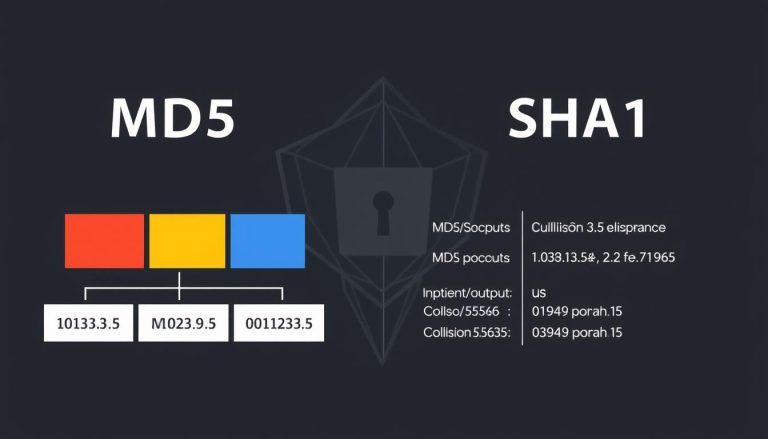Welcome to my article on asymmetric encryption, also known as public-key cryptography. In this section, I will provide a brief overview of what asymmetric encryption is and how it works. We will explore its benefits and disadvantages, compare it to symmetric cryptography, and examine some examples. Finally, we will delve into the history of asymmetric cryptography. So let’s get started!
Key Takeaways:
- Asymmetric encryption uses a pair of related keys for encryption and decryption.
- The public key is used to encrypt messages, while the private key is used to decrypt them.
- Asymmetric encryption provides increased security and is used in secure communication protocols.
- It is slower than symmetric encryption but offers enhanced security benefits.
- Examples of asymmetric encryption include RSA and elliptic curve cryptography (ECC).
How Does Asymmetric Cryptography Work?
Asymmetric cryptography, also known as public-key encryption, is a key component of secure communication. It uses a pair of keys – a public key and a private key – for encryption and decryption processes. The public key is freely shared and used to encrypt messages, while the private key is kept secret and used to decrypt the encrypted messages.
When someone wants to send a secure message to a recipient, they use the recipient’s public key to encrypt the message. This encrypted message can only be decrypted by the recipient using their private key, ensuring that the message is secure and can’t be read by unauthorized parties.
One of the key advantages of asymmetric cryptography is that it eliminates the need for key exchange between communicating parties. In traditional symmetric encryption, both parties would need to exchange and safeguard a shared secret key. With asymmetric encryption, each party has their own key pair, providing enhanced security and simplifying the encryption process.
| Advantages | Disadvantages |
|---|---|
|
|
Asymmetric cryptography is widely used in various applications, including secure email communication, establishing secure connections over the internet (such as in HTTPS protocols), and digital signatures. It provides a robust and reliable method for secure data transmission and plays a vital role in ensuring data privacy and integrity in today’s digital world.
Benefits and Disadvantages of Asymmetric Cryptography
Asymmetric cryptography offers several benefits that contribute to its widespread use in secure communication protocols and other applications. One of the main advantages is increased security. Unlike symmetric cryptography, where the same key is used for both encryption and decryption, asymmetric cryptography uses a pair of related keys – a public key and a private key. The private key is kept secret by the recipient, while the public key can be freely distributed. This means that even if the public key is intercepted, it cannot be used to decrypt messages without the corresponding private key. This enhances data security by reducing the risk of unauthorized access to sensitive information.
Another benefit of asymmetric cryptography is the use of digital signatures for authentication and nonrepudiation. A digital signature is a mathematical algorithm applied to a message using the sender’s private key. The recipient can then use the sender’s public key to verify the integrity and authenticity of the message. This ensures that the message has not been tampered with during transmission and that it was indeed sent by the claimed sender. Digital signatures are essential for secure online transactions, as they provide a way to verify the identity of the sender and prevent denial of involvement in the transaction.
Despite its advantages, asymmetric cryptography also has some disadvantages. One of the main drawbacks is its slower performance compared to symmetric cryptography. Asymmetric encryption and decryption operations require complex mathematical calculations, which can be computationally intensive and time-consuming. This makes asymmetric cryptography less suitable for encrypting large amounts of data. In such cases, symmetric cryptography, which is faster, may be a more practical choice. Additionally, if a private key is lost or compromised, all messages encrypted with that key become accessible to unauthorized individuals. Therefore, the security of the private key is of utmost importance in asymmetric cryptography.
Table: Comparison of Benefits and Disadvantages of Asymmetric Cryptography
| Benefits | Disadvantages |
|---|---|
| Increased data security | Slower performance compared to symmetric cryptography |
| Use of digital signatures for authentication and nonrepudiation | Risk of private key loss or compromise |
Overall, the benefits of asymmetric cryptography, such as increased security and the use of digital signatures, outweigh its disadvantages. Understanding the trade-offs between asymmetric and symmetric cryptography is crucial for choosing the appropriate encryption method based on specific security requirements and performance considerations.
Asymmetric vs. Symmetric Cryptography
When it comes to cryptographic algorithms, one of the key distinctions is between asymmetric and symmetric cryptography. While both methods are used to encrypt and decrypt messages, they differ in terms of the number of keys used and the overall level of security they provide.
Asymmetric cryptography, also known as public-key cryptography, utilizes a pair of keys – a public key and a private key. The public key is used for encryption, while the private key is used for decryption. This approach eliminates the need to exchange keys between sender and recipient, making it ideal for secure communication over untrusted networks like the internet. One of the most well-known asymmetric encryption algorithms is RSA encryption, which requires longer keys to achieve the same level of security as symmetric encryption.
In contrast, symmetric cryptography employs a single key for both encryption and decryption. This key must be securely shared between the sender and the recipient to ensure the confidentiality of the encrypted message. While symmetric encryption is faster than its asymmetric counterpart, it presents challenges in terms of key distribution. If the key is compromised, the entire system becomes vulnerable to unauthorized access.
Table: Comparing Asymmetric and Symmetric Cryptography
| Feature | Asymmetric Cryptography | Symmetric Cryptography |
|---|---|---|
| Number of Keys | Two: a public key and a private key | One: a shared key |
| Key Distribution | Keys do not need to be exchanged | Keys must be securely shared |
| Security | Enhanced security through the use of longer keys | Lower security due to the need for key distribution |
| Speed | Slower than symmetric encryption | Faster than asymmetric encryption |
Ultimately, the choice between asymmetric and symmetric cryptography depends on the specific requirements of the application or system. Asymmetric encryption offers enhanced security and ease of key management but comes with a performance trade-off. Symmetric encryption, on the other hand, provides faster encryption and decryption speeds but requires a secure key distribution mechanism. Understanding the strengths and weaknesses of each approach is crucial for implementing effective data security measures.
Examples of Asymmetric Cryptography
Asymmetric cryptography has several notable examples that are widely used in various applications. The most prominent example is the RSA encryption algorithm, which stands for Rivest, Shamir, and Adleman, the inventors of the algorithm. RSA encryption is embedded in protocols like SSL/TLS to ensure secure communication over the internet. It uses a pair of keys, a public key for encryption and a private key for decryption, making it a fundamental component of asymmetric cryptography.
Another example of asymmetric cryptography is elliptic curve cryptography (ECC). ECC offers smaller key sizes and faster performance compared to RSA encryption. It is particularly useful in resource-constrained environments where computational efficiency is crucial. ECC has gained popularity in applications like encrypted email and secure messaging, providing a more efficient alternative to RSA encryption.
In addition to RSA and ECC, there are other asymmetric cryptographic algorithms such as Diffie-Hellman key exchange, ElGamal encryption, and DSA (Digital Signature Algorithm). These algorithms are used in various security protocols and applications, including digital signatures, encrypted communication, and securing transactions in cryptocurrencies like Bitcoin.
| Asymmetric Cryptographic Algorithm | Key Features |
|---|---|
| RSA | Used in SSL/TLS, encryption and decryption with public and private keys |
| ECC | Provides smaller key sizes and faster performance |
| Diffie-Hellman | Key exchange protocol for secure communication |
| ElGamal | Encryption algorithm based on the Diffie-Hellman key exchange |
| DSA | Digital Signature Algorithm for secure authentication and non-repudiation |
These examples showcase the versatility and effectiveness of asymmetric cryptography in ensuring secure and reliable communication in today’s digital world.
History of Asymmetric Cryptography
Asymmetric cryptography, also known as public-key cryptography, has a fascinating history that dates back to the late 1970s. It all began with the groundbreaking work of two researchers, Whitfield Diffie and Martin Hellman, who published a paper titled “New Directions in Cryptography.” This paper introduced the concept of public-key cryptography and set the foundation for modern encryption techniques.
One of the most significant advancements in asymmetric cryptography came in 1978 when Ron Rivest, Adi Shamir, and Leonard Adleman developed the RSA algorithm. Named after its inventors, the RSA algorithm became a cornerstone in the field of cryptography and is still widely used today. This algorithm revolutionized encryption by introducing the concept of using a pair of related keys – one public and one private – for secure communication.
Another important development in asymmetric cryptography is the Diffie-Hellman key exchange. Proposed by Diffie and Hellman in the same paper that introduced public-key cryptography, this key exchange protocol allows two parties to establish a shared secret key over an insecure network. The Diffie-Hellman key exchange forms the basis of many secure communication protocols, such as SSL/TLS, and is essential in ensuring secure online transactions and data privacy.
| Year | Development |
|---|---|
| 1976 | Diffie-Hellman key exchange proposed by Whitfield Diffie and Martin Hellman |
| 1978 | RSA algorithm invented by Ron Rivest, Adi Shamir, and Leonard Adleman |
The history of asymmetric cryptography is a testament to the continuous advancements in securing digital communication and information exchange. From the groundbreaking work of Diffie and Hellman to the invention of the RSA algorithm, these developments have paved the way for secure online transactions, encrypted email, and the widespread adoption of cryptographic protocols. As technology continues to evolve, it is essential to understand the history and development of asymmetric cryptography to ensure the privacy and security of our digital world.
Conclusion
In conclusion, asymmetric encryption, also known as public-key cryptography, is a vital tool for ensuring data security in today’s digital world. By utilizing a pair of related keys – a public key and a private key – asymmetric encryption provides increased security and allows for secure communication over the internet.
The benefits of asymmetric cryptography are numerous. With the use of digital signatures, it enables authentication and nonrepudiation. Additionally, the private keys used in asymmetric encryption do not need to be shared, further enhancing data security.
However, it’s important to understand the limitations of asymmetric cryptography. While it offers enhanced security, it is slower than symmetric cryptography and not suitable for decrypting bulk messages. Moreover, if a private key is lost or compromised, unauthorized individuals can gain access to encrypted messages.
Overall, the application of asymmetric encryption is widespread and diverse. From encrypted email to secure communication protocols, and even cryptocurrencies like Bitcoin, this encryption method plays a crucial role in safeguarding sensitive information and ensuring data privacy.
FAQ
What is asymmetric encryption?
Asymmetric encryption, also known as public-key cryptography, uses a pair of related keys – one public key and one private key – to encrypt and decrypt messages.
How does asymmetric cryptography work?
Asymmetric cryptography employs a pair of keys – a public key and a private key – for encryption and decryption. When someone wants to send an encrypted message, they use the recipient’s public key to encrypt it. The recipient then uses their private key to decrypt the message.
What are the benefits and disadvantages of asymmetric cryptography?
The benefits of asymmetric cryptography include increased security, the use of digital signatures for authentication, and nonrepudiation. However, it is slower than symmetric cryptography and not suitable for decrypting bulk messages. If a private key is lost or compromised, the messages encrypted with it can be accessed by unauthorized individuals.
What is the difference between asymmetric and symmetric cryptography?
The main difference lies in the number of keys used. Asymmetric encryption uses a pair of keys, a public key for encryption and a private key for decryption. On the other hand, symmetric encryption uses a single key for both encryption and decryption. Asymmetric encryption requires longer keys to provide the same level of security as symmetric encryption. Asymmetric encryption is slower but offers enhanced security, while symmetric encryption is faster but requires secure key distribution.
What are some examples of asymmetric cryptography?
Examples of asymmetric cryptography include the RSA algorithm, which is widely used in protocols like SSL/TLS, and elliptic curve cryptography (ECC), which offers smaller key sizes and faster performance compared to RSA. Asymmetric cryptography is used in various applications, such as digital signatures, encrypted email, and cryptocurrencies like Bitcoin.
What is the history of asymmetric cryptography?
Asymmetric cryptography was first proposed in the late 1970s by researchers Whitfield Diffie and Martin Hellman. Their paper on “New Directions in Cryptography” introduced the concept of public-key cryptography. The RSA algorithm, named after its inventors Ron Rivest, Adi Shamir, and Leonard Adleman, was published in 1978 and has become one of the most widely used asymmetric encryption algorithms.
How does asymmetric encryption ensure data security?
Asymmetric encryption, also known as public-key cryptography, is a secure encryption method that provides increased security, allows for authentication through digital signatures, and has various applications in secure communication protocols, email encryption, and cryptocurrencies.
Cathy is a senior blogger and editor in chief at text-center.com.


